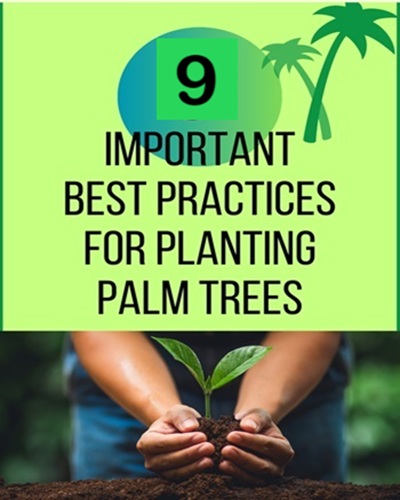- Home
- Tips to Grow Palms
- Planting Palm Trees
How to Plant Palm Trees - Essential Best Practices
Knowing how to plant palm trees correctly can give tropical beauty to your landscape.
But how do you do it right? How do you get started?
With advice from palm experts (like Broschat & Meerow) our palm tree planting guide shares the best practices to help your palm grow successfully.
Feeling overwhelmed by so many palm trees?
You're not alone. We Understand your headaches! At Mission: Palm Trees you'll find clear answers to questions & Step-By-Step Guidance, from real people. With solutions to help. No puzzling shoptalk. No tiring research. So it's easy & fun for you.
1 - Think Long-Term: Plan Before You Plant
What method will you use to know how to plant palm trees?
- Planting a palm purchased From a Nursery for Transplanting.
- Planting a palm by Starting From Seed.
- Planting a palm from Other Propagation Methods
Before digging, consider your palm’s future size.
Palms can grow tall and/or wide, depending on the species. Give them enough space away from buildings, fences, and pathways. To help you avoid costly mistakes later.
- Planting a palm tree near a house is generally not a good idea.
- Think about how this plant will enhance your landscape.
- Have you thought about Advance Plans for your planting arrangement?
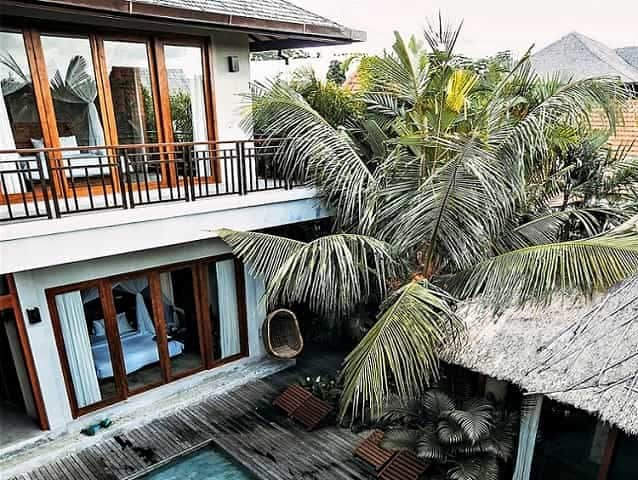 Poor Planning when this palm was placed too near the homes.
Poor Planning when this palm was placed too near the homes.2 - Choose the Right Palm for the Right Place
Different palm species have different needs.
Not every palm suits every yard.
- Consider your local climate
- Consider the palm’s sun, soil (along with its Nutritional Needs), and water requirements
- Consider how the Palm Tree Fruit or flowers fit your setting.
Need help picking that best palm for you. Our Site Map Index has information that can guide your research.
 Palms along the Ocklawaha River like this wet environment - Vintage Florida Postcard
Palms along the Ocklawaha River like this wet environment - Vintage Florida Postcard Versus arid climate needs of Medjool Date Palms
Versus arid climate needs of Medjool Date PalmsGrowing in the desert at Yuma Arizona
3 - Colder Climates? Yes, You Still Have Options
Even if you live outside the tropics or subtropics, palms can still work.
We've seen palms growing in tough places - like New Jersey, Norway, Germany etc.
- Know your USDA Plant Hardiness Zone before planting. Find It By Your Zip Code.
- Choose Cold-Hardy Varieties, which could work for you.
- Then be ready to Protect Young Palms From Frost. Once they're well established it's not so much of a worry.
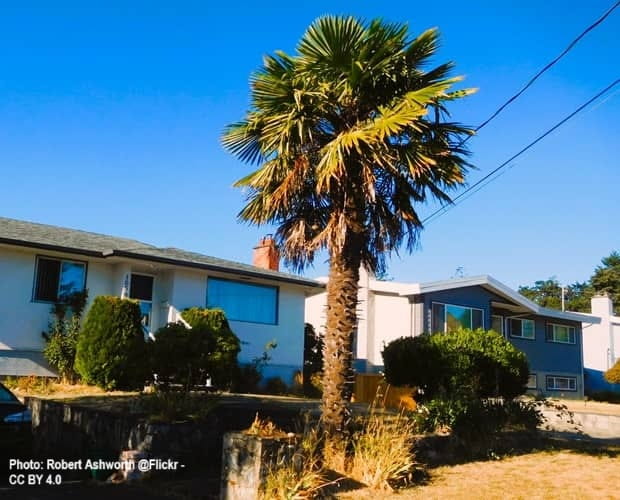 Adult Windmill Palm looking fine in Victoria, British Columbia, Canada
Adult Windmill Palm looking fine in Victoria, British Columbia, Canada4 - What Time of Year is Best to Transplant Palm Trees?
What month do you plant palm trees into a new location?
Timing affects the foundation for a successful palm.
- In tropical zones, you can plant year-round. Just avoid planting palm trees during cold snaps.
- Elsewhere, aim for late spring through early fall. Your palm needs time to root well before winter.
 Winter is a No-No for palm planting
Winter is a No-No for palm plantingExcept for the tropics
5 - Find the Perfect Sunny (or not) Spot

Palms usually love lots of sunlight.
Choose a location with six or more hours of direct sun daily. It depends on the sunlight needs of various palm tree types.
- Watch for varieties that prefers less sun, getting more hours of partial shade. To plant in a shadier location.
- Watch for varieties that naturally grow under shady tall plants. These are often native to rainforests. For when you want to plant on the north side of your home.
Young palms often need temporary sun protection in hot climates. Set them up with a shade cloth.
6 - Soil Matters: Test It
Palms prefer well-draining, slightly acidic to neutral soil (pH 6.0 to 7.0).
Poor drainage or a pH less than 6.0 (very acidic) can stunt or kill your palm.
Before planting your palm, it's best
- To Test Your Soil Type in case your palm choice is fussy.
- To test the drainage before planting. Waterlogged soil around a root ball decreases a palm's survival chances.
7 - Dig the Right Hole
How deep should you dig for a new palm?
A common question. Doing this correctly is important.
- Dig a hole twice as wide as the palm's container.
- The root ball should sit at the same depth as it did in the container.
- Never plant too deep - that can damage roots and prevent essential new roots from growing.
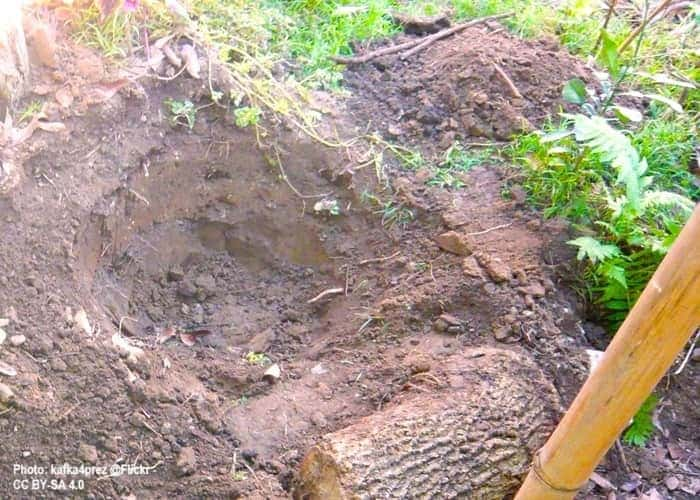 Once your hole is dug, no undrained water should be seen.
Once your hole is dug, no undrained water should be seen.8 - Set It Right into the Hole
Don't plant too shallow either.
Place your palm gently into the hole. Make sure the root ball is firmly in contact with the soil at the bottom of the hole.
Add fill using the soil you'd dug out. Tamp down as you go to remove air pockets that prevent new root growth.
After planting, the soil often settles.
- Do you see root shoots growing from the root initiation zone?
- Do you see roots above the container soil line?
- Do you see how you can cover these roots with soil?
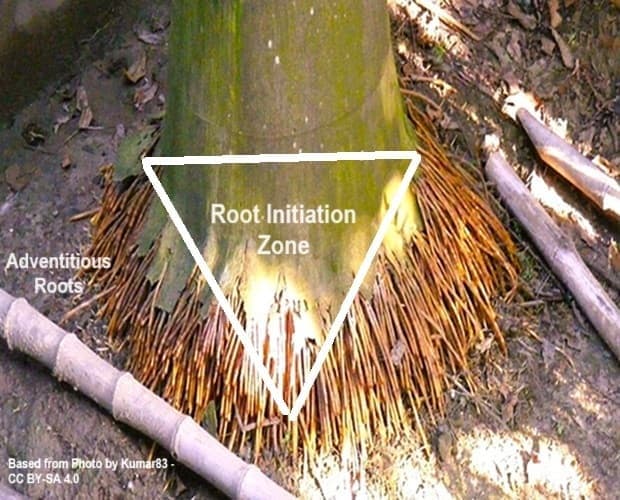 New roots grow from the palm's root initiation zone.
New roots grow from the palm's root initiation zone.9 - Water Your Newly Planted Palm
Now it's time to water your palm.
A best-practice is creating an embankment around the palm's trunk.
- To let water seep throughout the area below the crown, make the embankment wide enough.
- To gather the water for existing palm roots.
- To encourage new root growth into the backfilled soil.
Water deeply & thoroughly. It may take several fills to fully wet the soil. This also helps to settle out any leftover air pockets.
Afterwards, begin a regular watering schedule to maintain a moist (not saturated) soil environment. This jump-starts its much needed root growth. Since success with how to plant palm trees now depends on root development.
Watering Schedule for Newly Transplanted Palms
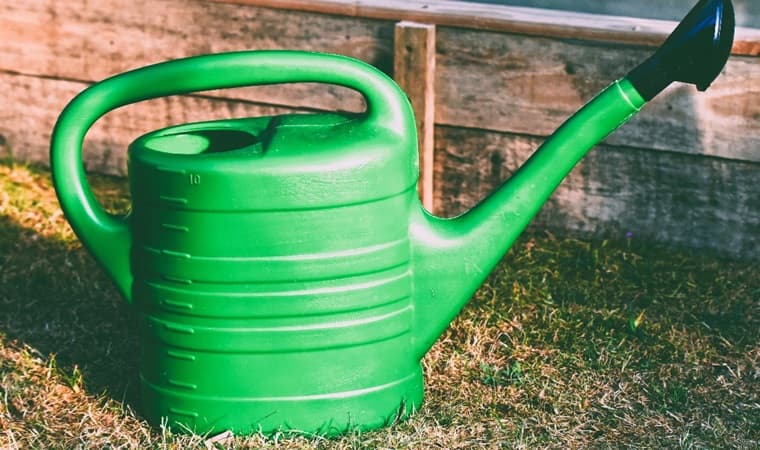
Continue watering the soil regularly to keep it moist.
Being careful that it's not over-drenched. No leaf water spray is needed & could even be harmful. Water sitting in frond crevices could encourage fungal attack.
Stick with that timetable for its first 4-6 months post planting. As your palm grows, it focuses its energy on growing new roots. Then you can adjust to a Normal Palm Watering To-Do List.
While this is happening, you won't see much, if any, new growth. Fronds will be secondary to roots during this beginning of establishment.
Some Landscape Design Tips When Planting Palms
Enhance your yard by pairing your palm
- With companion plants.
- With nighttime lighting.
Smaller, complementary plants add interest and balance to your design. Cycads work well, as they're slow-growing, usually in similar growing zones to yours, and have that tropical look.
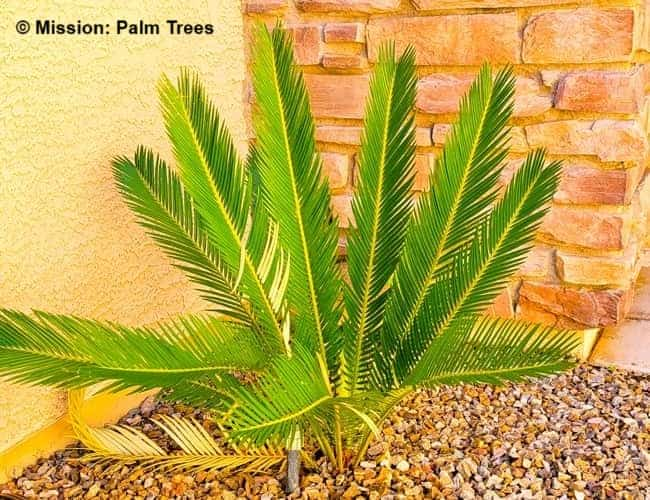 Cycads are a popular choice to use in palm landscaping.
Cycads are a popular choice to use in palm landscaping.FAQ for Planting Palm Trees
Do palm trees go into shock when planted?
Do palm trees go into shock when planted?
As long as the correct planting and follow-up steps are supported, little to no shock should be seen.
Some initial shock symptoms will usually be a bit of frond wilting. But once into their post-transplant care schedule, fronds will perk up.
Do palm trees transplant well?
Do palm trees transplant well?
Pretty much the answer is yes, for most palm species.
When comparing to transplanting shade trees like oaks, maples, etc. - palm trees have a much easier time. The roots are the main key, along with knowing How Palm Trees Grow - so differently that other trees.
Palm tree roots are quite different from common plants. The palm's root initiation zone begins continually growing out the needed roots after transplantation. And palm roots don't depend on the gradual width expansion that broadleaf trees need for success. They are a uniform width from the start.
Takeaways for How to Plant Palm Trees
Knowing how to plant palm trees is just the beginning of your journey.
Give your transplanted palm the right care and attention. Your palm will reward you by becoming a beautiful, long-lasting part of your landscape.
By following these best practices on how to plant palm trees, you're well on your way to giving your new palm tree the environment it needs for success. But if you're unsure about something or have questions, Feel Free to Ask Us.
We'll always see what we can do to help!
